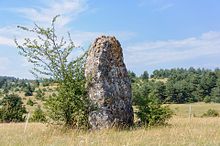Cupules
Cupules (kyoo'pyools) are humanly made depressions on rock surfaces that resemble the shape of a spherical cap or dome. They were made by direct percussion with hand-held hammer-stones, on vertical, sloping or horizontal rock panels. Cupules are the world’s most common rock art motifs, occurring in huge numbers in every continent except Antarctica. They were produced in many cultures, from the Lower Paleolithic to the 20th century, and they can be found on most lithologies. Similar artifacts from lithic Native American cultures are also known as cupstones.
The name cupule derives from the Late Latin cūpula, “little cask”. These features are usually between 1.5 and 10 cm in diameter, although larger specimens are occasionally seen. They occur commonly in groupings that may number several hundred; they may be arranged in geometric formations, such as aligned sets, or they occur in unstructured, random groups. Some specimens in the southern Kalahari Desert are suggested to be in the order of 410,000 years old, and those of two sites in central India should be even earlier. In Middle Paleolithic or Middle Stone Age contexts, cupules occur in Africa and Australia, and are attributable to that era also in Europe. They seem to become less common in the course of the European Upper Paleolithic, but still occur occasionally. Cupules are extremely common in the Neolithic and the Metal Ages of Europe, Asia and Africa, and in medieval Europe.
Surprisingly little is known about the purpose or significance of cupules. Many meanings or purposes have been suggested in the literature (one review lists 71). In a number of cases cupules were demonstrated to mark specific rocks used as lithophones; in some cases they served in board games; but other credible ethnographic interpretations of their former cultural functions have been secured in very few instances. These cannot necessarily be extrapolated to other corpora, which are widely separated temporally as well as spatially. Even the identification of cupules remains tenuous: archaeologists have encountered difficulties in distinguishing cupules from other features, such as potholes, mortars, querns, metates, tacitas, and small solution pans.
Typically cupules were created by direct percussion, i.e. using hand-held hammer-stones. Replication studies have shown that the time required for their production varies greatly, depending on the rock type. It can take one minute to create a 12 mm deep cupule on weathered sandstone, but 45,000 and 60,000 hammer-stone strokes on unweathered quartzite. The resistance of a rock to kinetic impact is determined by its hardness, toughness and strength. Hardness, in this context, is a complex articulation of several factors, essentially a measure of how resistant rock is to various kinds of permanent shape change when a compressive force is applied to it. These factors include scratch or abrasion resistance (Rosiwal scale), toughness, strength, ductility, indentation hardness (measured by the Brinell scale and expressed in BHN, or measured by the Vickers test and expressed in kg/mm²) and brittleness factor. Abrasion hardness, indentation hardness and brittleness factor (ratio of the uniaxial compressive strength and the uniaxial tensile strength) combine to determine the “composite hardness index” θ, which governs the production coefficient ρ:
...
Wikipedia

